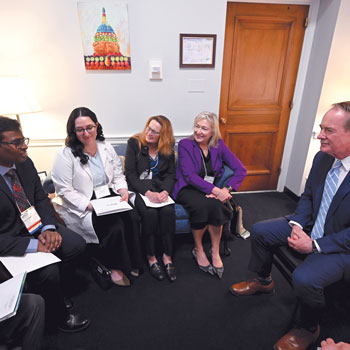Diamonds are forever, or are they?
It has been 60 years since Medicare and Medicaid were first established, and ACP will be advocating to protect, maintain, and improve both programs now and into the future.
Happy diamond anniversary! It has been 60 years since Medicare and Medicaid were first established on July 30, 1965, when President Lyndon B. Johnson signed into law the Medicare and Medicaid Act, also known as the Social Security Amendments of 1965. When Medicare was first implemented the following year, it covered most people ages 65 years and older. Originally, Medicare was made up of only two parts. One was Hospital Insurance, or Part A, which helps pay for inpatient hospital, home health agency, skilled nursing facility, and hospice care. The other was Supplementary Medical Insurance, or Part B, which covers physician, outpatient hospital, some home health agency, and other services. Part A is free to beneficiaries, while Part B requires all eligible people to pay a monthly premium. These two parts are considered “Original Medicare,” and the program has since been expanded to cover additional populations and to have additional programs.
In 1972, Medicare was expanded to cover individuals with disabilities, people with end-stage renal disease who require dialysis or kidney transplant, and additional people ages 65 years or older who opt into Medicare coverage. Additional expansions have since been made to include those with amyotrophic lateral sclerosis, asbestos-related diseases, and medical diagnoses related to other exposures to public health hazards.
The program has also expanded into additional “parts” since it was created. These include Part C, or what is now known as the Medicare Advantage program, which expands beneficiaries' options for participation in private-sector health plans, and Part D, which now provides subsidized access to prescription drug insurance coverage on a voluntary basis for all beneficiaries upon payment of a premium, with premium and cost-sharing subsidies for low-income enrollees. (Part D was originally implemented as a voluntary prescription drug discount card program.)
Medicaid began as a cooperative program jointly funded by the federal and state governments, including the District of Columbia and U.S. territories, to provide medical coverage to eligible persons in need. The program has broad national guidelines that are established by federal statutes, regulations, and other policies, while each state establishes its own eligibility standards; determines the type, scope, amount, and duration of services provided; sets the payment rates for services; and administers the program. This results in a program that is extremely complex and varies widely across the country.
Medicaid eligibility was expanded at the national level in 2014 under the Affordable Care Act, which broadened it to include all individuals younger than age 65 years in households with income up to 138% of the federal poverty level. The federal government paid 100% of the cost for this population from 2014 to 2016, then gradually dropped to 90% in 2020. The intent was for this expansion to be mandatory; however, in 2012, the Supreme Court effectively made this expanded eligibility optional for each state's Medicaid program. Therefore, some states chose not to expand their eligibility, and, as of 2025, 10 states still have not done so. This is despite additional incentives that were provided to states as part of the American Rescue Plan in 2021, which called for states that expanded Medicaid after March 2021 to receive a two-year, 5% increase in the federal matching rate for their nonexpansion enrollees.
It took nearly 20 years for Medicare and Medicaid to be established, beginning when President Harry S. Truman asked Congress to develop legislation to start a national health insurance plan, to which—perhaps not surprisingly—there were cries of “socialized medicine!” Now, both programs are extremely popular with the public. A recent KFF survey of over 1,300 adults in the U.S. found that 82% view Medicare positively and that 77% view Medicaid favorably. While there was some variation along party lines in the survey, most Democrats, Republicans, and independents had a positive outlook on both programs.
In addition to being popular, both programs are extremely effective. Medicare has served as a reliable and transparent payer since its inception and is expected to cover more than 80 million beneficiaries at a cost of about $1.5 trillion by 2030, according to an article published April 9, 2024, by the Journal of the American Academy of Orthopaedic Surgeons. While the program has its challenges, it has been “instrumental in providing eligible adults access to medical care and in reducing racial and ethnic disparities related to insurance coverage and care access,” the authors wrote.
Regarding Medicaid, a recent study published by the National Bureau of Economic Research (NBER) found that in states that expanded Medicaid, enrollment increased by 12% and the mortality of low-income adults was reduced by 2.5%, suggesting a 21% reduction in the mortality risk of new enrollees. This is aligned with an earlier study, published Sept. 13, 2012, in the New England Journal of Medicine, which also found that Medicaid expansions were associated with a significant reduction of 6.1% in all-cause mortality, with the greatest mortality reductions among older adults, non-White people, and residents of poorer counties. Additionally, Medicaid expansions also appear to be cost-effective, having direct budgetary costs of $5.4 million per life saved, the NBER study found.
With that said, both programs could certainly be improved. The Quality Payment Program in Medicare has significant flaws, particularly within the Merit-Based Incentive Payment System, and there are not enough Alternative Payment Models for physicians to join. On top of which, the Physician Fee Schedule (PFS) within Medicare Part B is the only component of Medicare that does not receive inflationary updates and is subject to budget neutrality. This essentially pits the medical community against each other, as an increase in payment for one set of services will lead to a decrease in payment for others, and any significant shifts in payment within the program lead to the overall pool of money being reduced. This has left physicians having to approach Congress each year to ask for money to be added into the program.
Two companion bills introduced in the current Congress would help address some of these issues. H.R. 879 and S. 1640, both titled the Medicare Patient Access and Practice Stabilization Act of 2025, would reverse the 2.83% payment cut that physicians have incurred in 2025 due to budget neutrality and provide a 2% payment update in 2025, which is approximately half of the current Medicare Economic Index, an inflationary measure for Medicare. This would help to stabilize physician practices and protect patients' access to Medicare.
Unfortunately, the House did not take this approach in their recently passed reconciliation bill (aka the “One Big Beautiful Bill Act”). While representatives recognized the need for an annual inflationary update to the PFS, and included a small one, the update they provided does not address the 2025 payment cut nor the historical devaluation of services within the PFS relative to inflation over the past 25 years. We need Congress to do more to ensure long-term physician payment reform and protect beneficiaries' access to care.
The Medicaid program could also be improved. Given its size and complexity, there is certainly some waste, fraud, and abuse, which the Republicans on Capitol Hill have stated they intend to root out. However, the House reconciliation bill, if passed through the Senate and signed into law, would do significant damage to Medicaid nationwide through changes to eligibility determination timeframes, implementation of work or “community engagement” requirements, modifications to cost-sharing requirements for certain expansion populations, and more. The Congressional Budget Office states that the provisions included in the bill would disqualify at least 7.7 million people from Medicaid coverage by 2034.
So, will these diamond anniversary programs last forever, or will the lack of appropriate and reasonable reforms do them in? ACP will certainly be advocating to protect, maintain, and improve both Medicare and Medicaid now and into the future. We invite all ACP members to join with us in these efforts by telling Congress about their experiences with these programs. To do this, all you need to do is join the ACP Advocates for Internal Medicine (AIM) Network and take action when we send you alerts. Your voice matters and is needed now more than ever. Let's ensure that these programs can maintain their success for the next 60 years and beyond.





